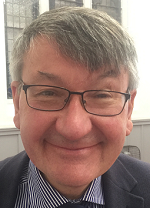 What is Scots?
What is Scots?
Professor Jeremy Smith was a hit. He spoke wittily about the Scots language and its diversity. Jeremy provided us with new insights to Scots and remnants of past cultures. Even although previous cultures and languages might be forgotten, place names are ‘fossils’ in the landscape. Place names give us clues to the past.
Jeremy illustrated this by using Paisley, Partick and Dumbarton as examples. Paisley is a derivative of basilica, Latin for church. Partick is derived from British or ancient Welsh for bush or thicket. And, Dumbarton is Gaelic for the Fort of the Britons. So even within a relatively compact area of Scotland, these place names have become fossils for a variety of languages. Place names also demonstrate merging of cultures. Jeremy proceeded to deconstruct Kirkcudbright. ‘Kirk’ is Scandinavian, ‘Cud’ is an abbreviation of Cuthbert (from Northumbria/ Durham) and ‘Bright’ is Anglo Saxon. Intriguingly the structure of Kirkcudbright follows Celtic principles! So a true merging of many cultures illustrated in a place name.
So what is the relationship between English and Scots, asked Jeremy? Well, it’s complicated and, of course, very interesting. Here to break things down Jeremy stratified English into a number of periods. Old English, also known as Anglo Saxon, was in use up to about 1100AD (the language of Beowulf), Middle English in use between 1100 and 1500 AD (the language of Chaucer) and Early Modern English was in use between 1500 and 1700AD (the language of Shakespeare). And, lastly, Late Modern English, which is still in use, started about 1700.
Turning to Scots and English in Scotland, the periods are slightly different. Old English was used up to about 1100 AD in the Lothians as in England, although sometimes known as Anglo Saxon or Old Northumbrian. Older Scots was used in pre-literary times between 1100 and 1375AD, Early Scots was used between 1375 and 1450AD and middle Scots was in use between 1450 and 1700AD. Scottish Standard English arrived about 1700 and coincides with the Union of Parliaments in 1707 and the Scottish Enlightenment.
Jeremy couldn’t let Robert Burns go past without a mention. He used Tam O’Shanter to illustrate nuances in Scots and English. Scots vernacular giving heightened emotion and feeling and English, the language of government and authority, used to convey censure. Therefore we hear ‘the sulky sullen dame’, ‘Gathering her brows like a gathering storm, Nursing her wrath to keep it warm’! Jeremy also nodded to how language gives us clues of class and power. Should we be surprised that elocution classes were all the rage in the 19th Century and lasted well into the 20th century. For anyone who was anyone, it was important to posh up!
Jeremy covered much, much more. For instance, reading the epic poem, Beowulf, he gave us a flavour of the original Old English. He also shared relic words like ‘numpty’ and ‘crabbit’ that have been given a new life through social media and Reggae respectively. Truly language and human beings go together, Jeremy’s key point.
Websites for further information : Place names : http://swap & http://spns.gla.ac.uk
Dictionaries : www.dsl.ac.uk & www.oed.com

Pingback:2019-20 Programme - Kelvin Probus